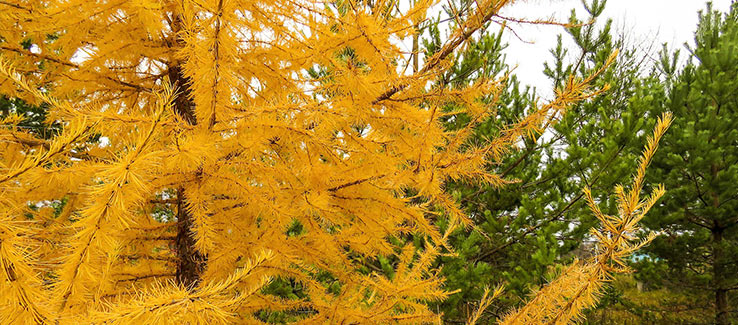Dying Pine Tree Diagnoses and Solutions
Prevent your dying pine tree from causing catastrophic damages to your property when it falls. Knowing how to diagnose what is killing your tree will help you act swiftly to solve the problem.
fasttreeremovalatlanta.com gathered the following information about dying pine trees, signs of diseases, infestations, parasitic growth that cause their decline, and what you can do to help them.
Dying Pine Trees
Like all other living things, pine trees have a beginning (seed germination), maturity, decline, and eventually, they die. At any stage of life, pines may become susceptible to or attacked by debilitating diseases, boring insect infestations, or life-threatening parasitic plant life. Due to the immense height and width these trees can reach, your immediate attention should be given when the following signs appear:
Dying Pine Tree Branches
When pine branches begin to brown and die, several factors may be at play. Consider the following:
Water Stress – During times of drought, tree stress may cause your pine to divert water and nutrients away from lower branches. This process causes browning and death to lower branches that can become brittle and suddenly drop.
Solutions: If a lack of water is causing your tree’s demise, the following can help:
- Mulch your pine(s) with 3-6 inches of organic mulch
- Install a drip line to provide a constant slow flow of water
- Deepwater your tree(s) every 10 to 15 days during a drought
- Prune out dead branches.
Salt or Deicing Chemicals – If you live in a region frequently impacted by snow, your pines closest to roadways may present dying lower or mid-level branches after repeated applications of salt and/or deicer. The same chemicals that make our roads safer can also adversely affect these branches and your pine’s overall health.
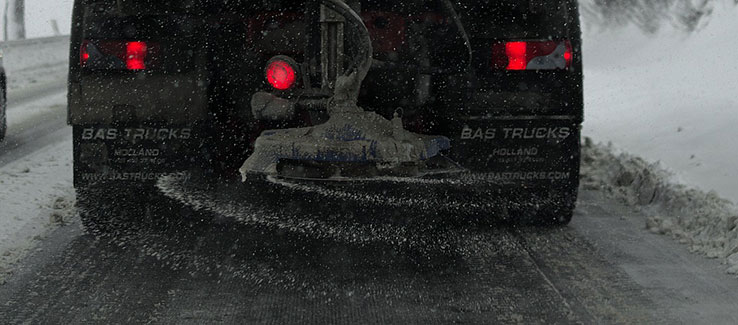
Solutions: While you could try to wash your trees free of these treatments, the following preventative measures can save you time and effort:
- Choose better planting locations (further from the street)
- Have your trees transplanted away from the street
- Use burlap to wrap the tree’s branches
- Erect a burlap barrier (fence-like) between the trees and street
- Raise the crown, so lower branches are out of reach, then lay a 6-inch layer of organic mulch around the tree to keep chemicals from reaching the root system
Note: If you raise the crown and apply mulch to the root plate, be prepared to replace the mulch after salt or deicer are applied to the streets.
Disease – Tree diseases can move from host to host by multiple vectors, including:
- Mechanical or weather-related Injury
- Insect Infestation
- Splashing Water
- Poor Soil Drainage
- Unsterilized Pruning Equipment
Signs that your pine tree is diseased include:
- Browning and loss of inner needles of lower branches (Rhizosphaera needle cast)
- Needle discoloration from green to yellow, then brown through the tree (Pine wilt)
- Brown, gray, yellow needles on new growth, branch dieback, oozing sap, cankers on stems and/or branches (Sphaeropsis tip blight)
- Dark green bands appearing on needles turning into brown or reddish-brown lesions and oozing sap (Dothistroma Needle Blight)
- Wilting, severe chlorosis, stunted foliage, mushroom conks at the base, and/or dead feeder roots (root rot)
Note: A tree with advanced root rot may begin to lean as its roots can no longer support its weight. This condition requires immediate professional attention.
Solutions: When caught and diagnosed in the initial stages, most pine diseases can be successfully treated with minimal to moderate damage to the tree. Some effective treatments include:
- Improving soil conditions for better drainage
- Pruning out affected branches
- Root pruning (for younger pines)
- Neem oil application
- Copper fungicide sprays or powders
Most fungicides require multiple applications between spring and the end of summer. These and other chemical applications should be administered by an ISA certified arborist. An arborist is trained to detect and treat tree issues and knows when to recommend tree removal.
Note: Always sterilize your equipment before working on your trees and between trees. You can accomplish this by dipping or spraying equipment using a 20% bleach to 80% water solution.
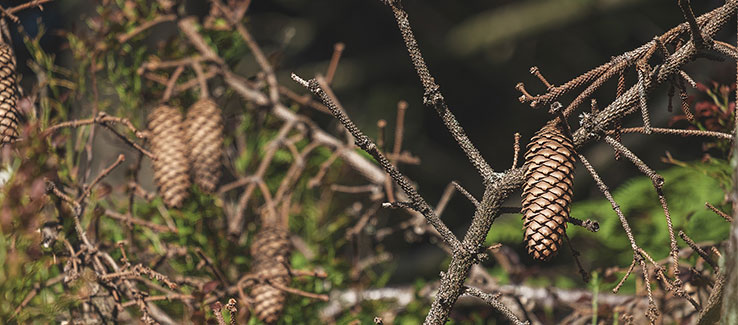
Pine Tree Insect Infestation
A wide variety of insects seek refuge, nest, and reproduce in pine trees. Many of these insects inflict minimal harm on their host. However, there are species of insects that bore into the cambium layer (the water and nutrient transportation system containing the xylem and phloem), consuming the tree’s rich nutrients while in its larval stage. Boring insects that affect pine trees include:
Bark Beetle (Ips pini) – Multiple generations of this beetle will infest and re-infest a declining host pine. These beetles also serve as a vector for a blue-stain fungus that aggressively attacks the plant’s vascular system.
Pine Sawyer Beetle (Monochamus scutellatus) – When this beetle successfully attacks a pine tree, it leaves a 3/8” hole in the bark with exceptional amounts of frass (wood shavings and excrement) left behind from boring activity. This borer is a common vector for the “pine wilt nematode.” The nematode is a roundworm that quickly clogs the tree’s circulatory system. This causes hydraulic failure and sudden death.
Southern Pine Beetle (Dendroctonus frontalis) – This beetle species can produce six or more generations within a single calendar year. Boring activities from the larvae produce tunnels or galleries that disrupt the cambium layer, girdle the tree, result in hydraulic failure, and eventual death.
Signs of a boring insect infestation may include:
- Sightings or captured adult insects
- Entry and/or exit holes
- Excessively oozing sap (the tree’s response to boring activities)
- Frass left on the trunk and/or limbs
- Needle chlorosis (yellow or reddish-brown)
- Severe wilting of needles
- Curling or drooping of limbs (younger trees)
- Sudden overall decline or death
- Increased or unusual woodpecker or squirrel activity
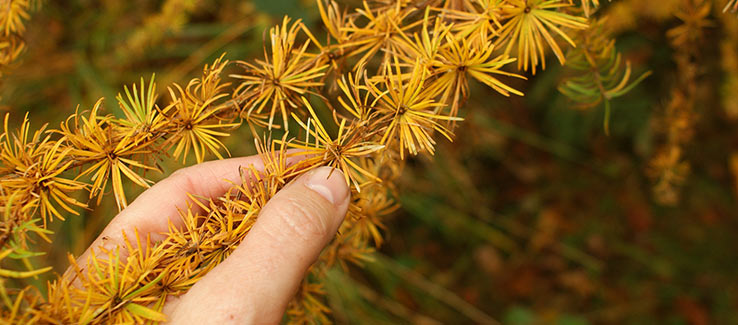
Solutions: Treating trees for boring insect infestations may require multi-faceted approaches to preserve surviving trees. Such approaches may include:
- Trapping adult insects
- Extensive pruning of infested trees
- Chemical deterrents applied to un-infested trees
- Careful removal of dying or dead specimens
- Promote tree health and vigorous growth (watering, fertilizing, pruning, mulching, etc.)
Tip: Don’t try to treat a boring insect infestation alone. Hire an ISA certified arborist to properly identify and treat the pending threat to your pine tree. An arborist’s documentation and reporting of such infestations to the US Forest Service, local, and state forestry departments play a vital role in tracking, early detection, prevention, and treatment.
Parasitic Plants and Climbing Vines
Sometimes, your pine trees become hosts to parasitic plant life that can overgrow, overshadow, and outcompete even the hardiest of trees. Consider the following:
Mistletoe – On pines, mistletoe appears as small yellow or green leafless plants. This parasitic plant absorbs both water and nutrients from its host tree, eventually weakening the tree, causing its deformation, and eventually killing it. A pine weakened by mistletoe can easily be infested by boring insects or infected by destructive diseases.
Solutions: Mistletoe does not have a simple solution. Once it has established itself on a host, there is only so much you can do without inflicting significant harm on the host tree. Such as:
- Pruning out infected branches (considered the best way to control mistletoe)
- Cutting off the mistletoe flush with the bark (it will grow back)
- Chemical control with ethephon (growth regulator) will cause some of this parasite to fall off. However, the mistletoe will eventually regrow at the same location requiring re-treatment.
Note: A severe mistletoe infestation may require the tree’s removal.
Lichens – Lichens are formed when a symbiotic relationship occurs between a fungus and an algal partner. They can spread and grow on nearly any surface and do not have any leaves, stems, or roots. Commonly found on trees, lichens are frequently misinterpreted as being a sign of decay within the tree. However, unlike the fungi that feed off of a tree’s decaying wood, the rhizines (multicellular root-like structures) of lichen only anchor its body to the tree.
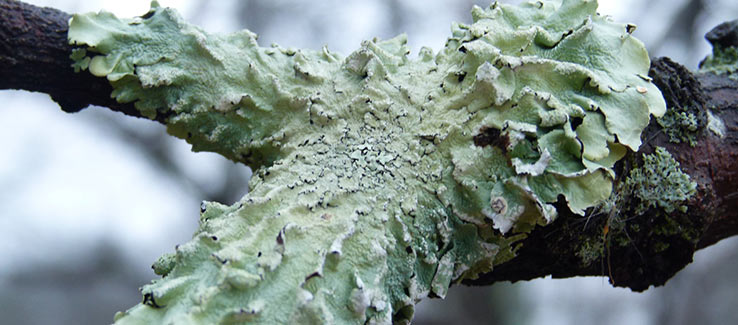
Solution: No action required. Lichens do not present any hazards or danger to pine trees. If your pine tree(s) are in decline, look for signs of disease or insect infestation.
Read more about lichens at fasttreeremovalatlanta.com/will-this-green-mold-lichens-kill-my-tree
Climbing Vines – Vines like English ivy, wisteria, or yellow jessamine can climb and wrap around your pine tree. Vines grow much faster than trees and can quickly overrun them if not dealt with immediately. This growth can cause your tree’s girdling or cover enough of the canopy to significantly reduce the amount of sunlight needed for photosynthesis. Either way, climbing and circling vines are bad news for the longevity of the host tree.
Solutions: While the vine’s removal from the tree may seem like the logical course of action, it is not. Consider the following:
- Locate the main trunk of the vine and sever it as close to the ground as possible
- Leave the vine attached to the tree, it will die, and the tree will recover
- The only part of the vine that should be carefully cut away is where it completely circles the tree
- To avoid regrowth, apply an herbicide to the vine’s stump or pull up and destroy as much of the root system as possible
Note: As a vine climbs or circles your tree, it literally “glues” itself to the bark. Trying to pull the vine off the tree can cause severe bark damage.
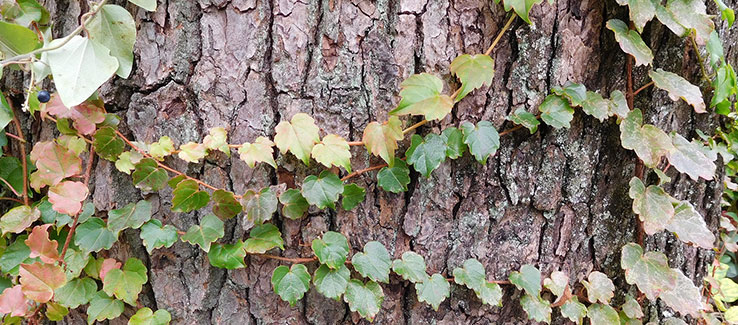
How To Save a Dying Pine Tree
In this article, you discovered essential information about dying pine trees, the signs of invasive diseases, destructive insect infestations, and parasitic plant life.
Knowing how to identify disease, insects, and invasive plant species that can harm your pine tree allows you to eliminate those threats and potentially restore your tree’s health.
Ignoring the signs of disease, infestation, and decline will ultimately result in the tree’s death and/or removal before causing costly property damages when it suddenly destabilizes and falls.
Sources:
extension.psu.edu/pine-diseases
extension.psu.edu/diplodia-sphaeropsis-tip-blight
extension.colostate.edu/topic-areas/yard-garden/pine-wilt-disease-2-915/
srs.fs.usda.gov/compass/2016/11/09/diagnosing-and-managing-for-root-disease-in-southern-pines/
extension.entm.purdue.edu/publications/E-256/E-256.html
ipm.ucanr.edu/PMG/PESTNOTES/pn7437.html
(404) 220-9965
(404) 220-9963

